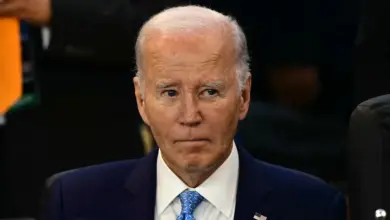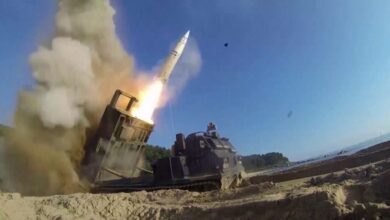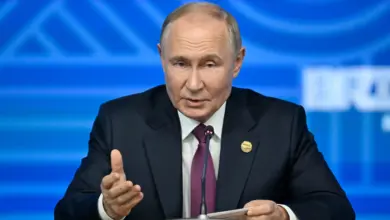
Lviv, Ukraine (CNN) – It was everything and nothing.
After weeks of Western warnings of a multi-pronged, country-wide Russian invasion, Vladimir Putin’s first military move on Ukraine was comparatively minor.
The Kremlin’s recognition on Monday of the two separatist republics and decision to send Russian troops is the outrageous formalization of something that has already happened. I witnessed, in the early days of separatist gangs taking over the Donetsk administration in 2014, two men in navy military jumpers and matching buzzcuts, handing out Kenwood radios to protestors inside the administration’s inner offices. This has always been an organized, Russian exercise — it is just now they may soon have their flag flying over it. The violation of Ukraine’s sovereignty happened eight years ago, signing the decrees and ordering in troops makes it more visible.
But this is not a full invasion. It is not the 150,000 troops and enablers — many in “tactical formation” — threatening Kyiv and toppling the government, as Western officials warned. That nightmare scenario forecast shock and awe bombing, followed by tens of thousands of troops, causing potentially tens of thousands of civilian casualties and millions of refugees.
What comes next is fluid.
Firstly, the Western response will have to choose how many of the sanctions at their disposal they deploy. Sanctions are a finite pot of options, not an infinite toolkit.
European nations that waivered may suggest this formalized incursion does not merit pressing the sanctions doomsday button, although the initial pause on the Nord Stream 2 pipeline by Germany suggests a tough response may emerge. The White House has suggested it will sanction trade with the separatist republics — which is basically a threat against Russian firms that do business there. Putin may be seeking to accentuate the divisions between Western capitals on sanctions by forcing them to respond to this incremental move.
Secondly, this is not the best option for Putin in the long-term. He now publicly owns the separatist issue. He no longer has the cloak of deniability and has pledged to send in Russian troops to back them up. These troops will likely be near a febrile line of conflict with Ukraine. Some may get hit in the ongoing exchanges. Putin may need to respond. It certainly does not herald peace, or a stable military status quo.
So, is this where it ends? Is this the sum of what Putin wants? Russian political figures have been debating whether Moscow should recognize not just the separatist republics as they are, but as they want to be — covering the whole of the Donetsk and Luhansk regions. That would mean Russian troops are effectively guaranteeing security in areas of Ukraine’s east that Ukraine’s army holds. At the time of writing, this remained unclear. But it is a possible window to escalation.
Does this initial move fit into a wider Russian military plan? It is hard to see how you would preface the imminent widespread attack the US has warned of with this limited formalization of control. But it is important to remember Putin does not work to a 24-hour news cycle. He has no congressional approval to seek, or mid-terms looming. He can do whatever he likes, whenever he likes, for as long as he likes. And while Western officials may think his troops at the border have a “matter of days” left in which the most advanced can stay in “tactical formation” to invade, the Russian military may not be that concerned about getting them back to barracks and a hot shower.
Any Russian “peacekeepers” — to use Putin’s words — in Donbas might be designed to keep Ukrainian military focus on the east. Western officials have warned the Russian plan is to sweep in from Ukraine’s northern borders and isolate the bulk of Ukraine’s military in the east from the capital Kyiv, facilitating the Kremlin’s likely bid for regime change. These first Russian arrivals in Donbas — presuming they do roll in — could be designed to keep Ukraine’s focus out east.
Or this really might be it, for now. Putin often functions in tiny incremental steps — the judo player adjusting his grip, rather than the heavyweight slinging a punch. The next step may come in the summer, or next year. The Kremlin head seems to relish the character dissection his every move generates. Depending on the analyst and the day, he is the pragmatist who responds to every event as a deft opportunist; or he is the rational, strategic 5D chess player, running riot in geopolitics. We don’t know which Putin we will deal with.
But we did get a chance to see one Putin Monday night. As some analysts commented, the most troubling development of the past 48 hours was perhaps the state of mind and political convictions betrayed by his 57-minute address to Russia. Part revisionist history lesson, part NATO critique, part tirade against Ukraine’s mere existence, this was not the rational chess player on display. It echoed the angry authoritarian we had seen hours earlier, sat tens of meters away from the tiny group of officials he had permitted into the same room as him, berating his closest advisors to “speak up” and “talk directly.”
The address displayed an isolated man, disinterested in the concerns of ordinary Russians — speaking primarily to himself, or to imagined history books, or a possible clique of potential successors — about his long-standing grievances accumulated since 1989. He even took a moment to get upset at how Bill Clinton snubbed him 22 years ago. This may have been a contrived performance, designed to unsettle anyone watching, in which case it was extremely effective. Or it may be the clearest exposition yet of what drives the singular personality behind Europe’s biggest crisis in decades, and what may fuel its future.




